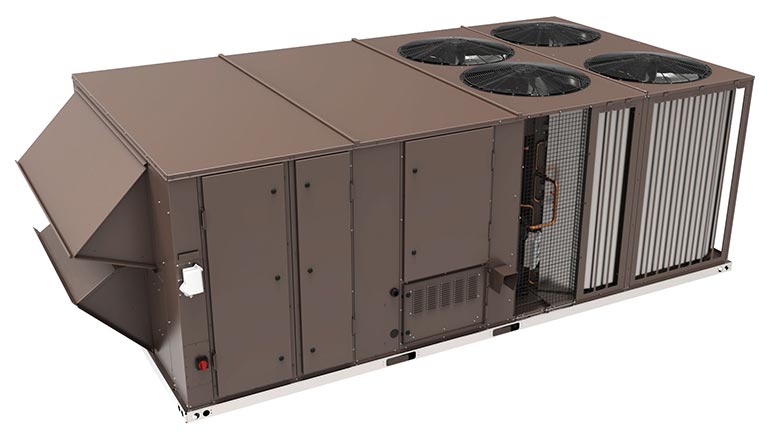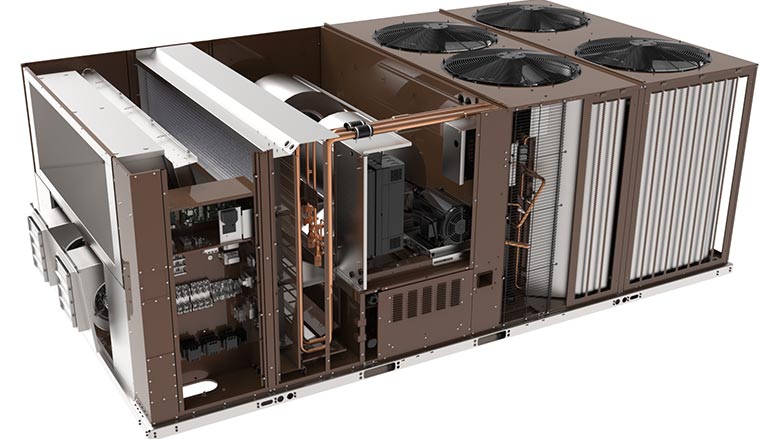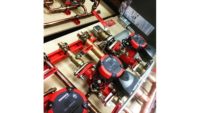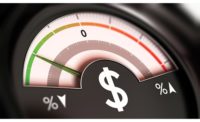When the United States rejoined the Paris Agreement, the deadline to cut global carbon emissions in half by 2030 felt somewhat far off. But now, with less than a decade to realize these resolutions, the built environment has been disrupted by rapidly changing efficiency standards and surging fuel costs. As the commercial building sector progresses toward decarbonization, many experts point to HVAC efficiency and electrification as a vital component in achieving sustainability.
This article will discuss the growing interest in commercial heat pumps, how they contribute to lowering building emissions, and the incentives and benefits that are driving the upward trajectory of the category.
What is driving decarbonization and why is it important for the built environment?
Buildings account for nearly 40% of global greenhouse gas emissions — 75% of which result from
operating buildings. Heating, cooling and ventilation are major contributors to commercial building energy use — both the private and public sectors are recognizing this as an opportunity to reduce emissions and gain operational cost-savings through the deployment of energy-efficient HVAC systems and advanced controls.
As a result, many building owners and operators are tasked with achieving greenhouse gas (GHG) emission reductions by meeting benchmarks established through corporate sustainability initiatives. In parallel, federal, state and local policymakers have also recognized the need to address the built environment in their climate strategies and the opportunities presented by HVAC efficiency and electrification in achieving their goals. In many cases, these initiatives become mandatory requirements.
Nationally, we’ve seen this with the implementation of the Department of Energy (DOE) 2023 energy conservation standards for commercial unitary air conditioners and heat pumps, which have raised energy efficiency requirements by some 20% since 2015. We’ve also seen recent updates to model building energy codes — such as the 2024 International Energy Conservation Code (IECC) and ASHRAE Standard 90.1 — that push HVAC system efficiencies for new construction. Locally, these policies include mandatory building performance standards (BPSs) that will drive retrofits of existing buildings to meet today’s energy efficiency standards.
The World Economic Forum estimates that 80% of buildings that exist today will still be in use as we approach the net zero goal posts in 2050, making building retrofits crucial to meeting this ambitious goal. Although there is not currently a nationally mandated BPS requirement, the National BPS Coalition has engaged several federal agencies including DOE and the Environmental Protection Agency (EPA) to mobilize adoption of these standards by key cities throughout the country. Whether these BPSs are based on site energy use, source energy use or carbon emissions per square foot, heat pumps and other high-efficiency HVAC systems can play a huge role in helping building owners meet these new requirements.


The YORK Sun Choice Rooftop Unit is a great example of how next-generation unitary heat pumps can deliver attractive ROIs by cutting energy usage. The RTU is available as a direct-fit heat pump up to 25 tons, and the ultra-high-efficiency model delivers the highest part-load efficiency in its class, surpassing DOE efficiency standards by up to 45%.
As sustainability requirements become increasingly more stringent, what role do electric heat pumps play in decarbonizing the commercial building sector?
Electrification of heating is a critical pillar of building decarbonization. By shifting from on-site fossil fuel combustion to efficient electric heat pumps, heating systems can utilize increasingly low-carbon electricity. Not only do heat pumps reduce carbon emissions, but because they can cut site energy consumption by two-thirds, they also help organizations reduce operational costs.
For many building owners and operators, ROI is vital to making these system upgrades. In fact, the 2021 Johnson Controls Energy Efficiency Indicator Survey found that 85% of those surveyed expressed energy cost savings as the top driver for investing in sustainability.
How has heat pump technology changed in recent years?
Older heat pump systems were primarily viewed as an option for cooling, and only providing heating at moderate outdoor temperatures, which typically limited their applications to warmer climates. Today’s high-efficiency heat pumps are engineered to provide reliable space heating while meeting the demands of colder climates. This technological evolution has led to several impressive innovations, including:
- Variable-speed scroll compressor technology — now used within ducted heat pump systems, variable-speed compressors can significantly improve performance at low ambient conditions;
- Ground source and water source heat pumps, which do not rely on outdoor air for heat transfer; and
- Applied air-to-water and water-to-water heat pumps, which can simultaneously provide heating and cooling to replace traditional boiler and chiller applications.
Most buildings can be at least partially electrified with a heat pump, but it is important to note that nearly all heat pump applications are installed with a backup heat source to maintain heating capacity during the coldest periods of the year. In many cases, a dual-fuel system, which uses fuel combustion as a backup heating source instead of inefficient electric resistance, can reduce source emissions and significantly reduce peak demand on the electric grid.
How are incentive programs driving adoption of heat pump systems?
The initial costs of advanced HVAC equipment are often the biggest hurdle for building professionals managing capital investments. Where available, initiatives such as Commercial Property-Assessed Clean Energy (CPACE) loans provide an opportunity to offset these upfront costs. The CPACE loan structure enables building owners to borrow money for energy efficiency projects and make repayments via an assessment on their property tax bill. CPACE loans are offered through state and local programs and in some cases have been expanded as a method to support building performance standards implementation.
For building managers with capital to invest, federal incentive programs such as the 179D tax deduction — significantly expanded by the passage of the Inflation Reduction Act (IRA) — can provide tax savings equivalent to up to $5 per square foot based on qualifying efficiency standards and net efficiency increases.
Additionally, many utilities offer incentives as part of the state policies to meet energy efficiency targets and, in some cases, GHG reduction targets. For example, the state of Massachusetts has established mandatory GHG reductions to be achieved through utility programs, and, as a result, programs through MassSave are expected to heavily incentivize heat pump systems.
Climate policies and incentive program implementation will vary from state to state and city to city, so programs can look very different depending upon the building location.
How do controls contribute to improved efficiency?
Intelligent building controls are vital for strategic building energy management. Today, many building systems contain some level of remote monitoring and/or automation. These can be powerful features in managing individual loads, but they often lack a holistic view into contextual, full building performance. Optimization of system- and component-level assets to achieve building- and portfolio-level outcomes, such as maintaining energy efficiency in response to shifting internal and external factors, is critical to achieving sustainability goals.
Programs are available that take building optimization a step further by integrating a data-informed algorithm and present building managers with ideal operational sequences. GHG emissions tracking enables building owners to set, track against and optimize for achievement of decarbonization targets at the building and portfolio levels. As these digital solutions evolve and “learn” from an expanding dataset of building performance, they’ll drive deeper user insights and enable increasingly beneficial outcomes.
As commercial heat pump technology continues to evolve, what additional advancements can engineers and contractors expect to see in the near future?
Decarbonization of the commercial building sector will require a combination of energy efficiency, electrification and digitalization strategies. Today’s advanced heat pumps encompass each of these factors to support an achievable path to sustainability. As market and regulatory drivers continue to increase demand for heat pumps, engineers and contractors should expect to see an increasing breadth of heat pump RTU options and performance, especially in colder climates.
Additionally, new opportunities will arise to deliver comprehensive services remotely, through features like automated fault detection and diagnostics, as digitalization provides more practical, data-informed insights.



